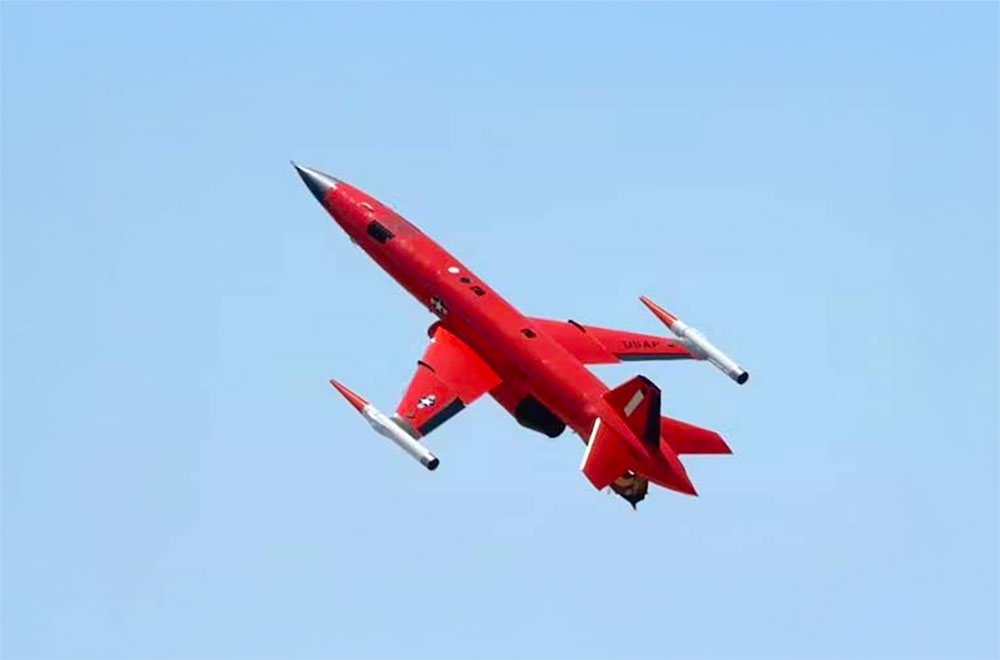Kratos BQM-167 Skeeter: High-speed target drone for U.S. Air Force, simulates enemy threats at up to 0.92 Mach for training exercises.
In brief
The Kratos BQM-167 Skeeter is an advanced aerial target drone developed by Kratos Defense & Security Solutions, initially designed by Composite Engineering Inc. This drone serves as a threat-emulation target, aiding the U.S. Air Force and the Department of Defense in air-to-air weapon testing and pilot training exercises. With a length of 20 feet (6.1 meters) and a wingspan of 11 feet (3.35 meters), the BQM-167 is built from carbon fiber and epoxy materials, which enhance durability and performance. Powered by a Microturbo Tri 60-5+ turbojet engine, it can achieve speeds of up to 0.92 Mach and altitudes up to 50,000 feet (15,240 meters). Its advanced payload capabilities, including infrared and radar systems, enable it to simulate diverse threats. The BQM-167 is launched with a rocket-assisted system and recovered via parachute, allowing for multiple uses with ease.
The Kratos BQM-167 Skeeter
The Kratos BQM-167 Skeeter is part of a series of subscale aerial targets used by the U.S. Air Force to support training and weapon testing. The Skeeter, introduced in the early 2000s, is a versatile platform that can emulate various aerial threats. Designed with cost-effectiveness in mind, it provides a realistic target for air combat training without the expenses associated with full-scale aerial targets. Since its debut, the BQM-167 has been central to the U.S. Air Force’s air-to-air training efforts.
History of the Development of the Kratos BQM-167 Skeeter
The BQM-167’s development began in the early 2000s as a replacement for the outdated MQM-107 and BQM-34 target drones, which no longer met the demands of modern aerial combat training. In 2001, Composite Engineering Inc. (later acquired by Kratos Defense) created two prototypes, and the BQM-167 was selected by the U.S. Air Force in 2002 as its next-generation aerial target. The program aimed to provide a drone that could simulate various aerial threats while offering enhanced durability and ease of recovery. After initial tests, the first production models were delivered in 2006, with the drone achieving initial operational capability by 2008.
Design of the Kratos BQM-167 Skeeter
The BQM-167 is engineered with a lightweight, composite airframe, utilizing carbon fiber and epoxy to balance strength and weight. This design allows it to achieve high speeds, reaching up to 0.92 Mach, and endure the rigors of aerial maneuvers. The drone’s wingspan of 11 feet (3.35 meters) and length of 20 feet (6.1 meters) are optimized for stability and control, with a streamlined fuselage and low-mounted wings. The drone is launched using a zero-length launch rail and rocket-assisted takeoff, while recovery is managed with a parachute system, allowing for repeated use with minimal damage. This drone can accommodate a range of payloads, including radar reflectors, electronic countermeasures, and flare dispensers, making it highly versatile for different training scenarios.

Performance of the Kratos BQM-167 Skeeter
Powered by a Microturbo Tri 60-5+ turbojet engine delivering 990 lbs (450 kg) of thrust, the BQM-167 can achieve speeds up to 690 mph (1,111 kph) and operates at altitudes up to 50,000 feet (15,240 meters). Its design supports high-G maneuvers, allowing it to simulate the performance characteristics of enemy aircraft effectively. Compared to other target drones like the QF-16, the BQM-167 offers a more cost-effective option with the ability to replicate multiple threat profiles. Its payload flexibility allows for a variety of configurations to enhance realism during training.
Variants of the Kratos BQM-167 Skeeter
The primary variant of this drone is the BQM-167A, which serves as the standard model for the U.S. Air Force. Additionally, Kratos developed the BQM-167I, a variant intended for international customers, although it has not been widely exported. This variant shares the same general specifications but may include region-specific modifications to meet foreign military requirements.
Military Use and Combat of the Kratos BQM-167 Skeeter
The BQM-167 is extensively used by the U.S. Air Force for air-to-air training, simulating threats posed by various aerial adversaries. Equipped with countermeasure systems and a radar signature that can be modified to mimic different aircraft, the BQM-167 enables realistic training environments for pilots and air defense systems. Notably, it has been employed in exercises at Tyndall Air Force Base, where it participates in live-fire exercises. The drone’s versatility allows it to emulate advanced threats, supporting a wide array of training scenarios that improve pilot proficiency. Although the BQM-167 is unarmed, its effectiveness as a target drone is enhanced by its speed, altitude capabilities, and payload options. As of recent reports, it remains actively used by the U.S. Air Force, with no immediate plans for replacement.
Back to the Drones, UAVs, UCAVs page